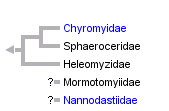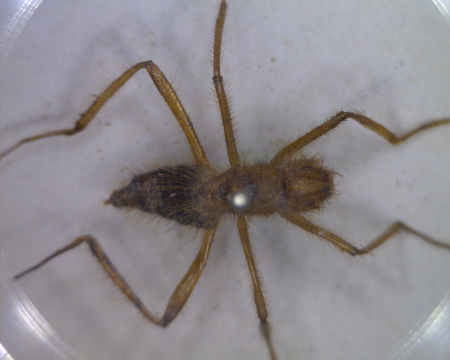So there has been a lot of talk in the media about the Terrible Hairy Fly and I thought that I would fill you in with some more details, including photographs of the material at the museum and tell you some more interesting facts about this amazing creature who, I have to agree does look a bit odd even to me!
We are talking about Mormotomyia hirsuta, which is the only species represented in this genus and this family. And to make matters more interesting we are not even really sure where they fit in with the rest of the Diptera! They have been tentatively placed near the Heleomyzidae (see below)
From the http://tolweb.org/tree?group=Sphaeroceroidea&contgroup=Schizophora
But other authors disagree and have placed it in Hippoboscoidea (see http://species.wikimedia.org/wiki/Hippoboscoidea) but all agree that it is odd, an outlier that needs to be sorted.
This was problematic though originally as the material that we had was collected either in 1933 or 1948. During that period the techniques available to describe species were limited to morphological descriptions, which generally suit the purpose wonderfully. However this species is odd, very odd and traditional methods for placing it into an evolutionary tree were not coping. For the majority if museum specimens it has been very had to extract any genetic material from specimens this old; only recently have we been haven any successes. Also there had been numerous expeditions to find fresh material of this elusive fly after the first two collecting events but all were unsuccessful. So the specimens have just sat there, looking weird in the drawer. Until recently that is, very recently!
It is so not often that I get to do this, but to quote the Daily Mail ‘It went missing for 62 years, but now Africa's 'terrible hairy fly' has been discovered in remote caves in Kenya. The insect, which does not have fully-formed wings and so is unable to fly, is one of the rarest creatures in the world.
And it may have been due to it being ‘Unable to fly and partial to breeding in bat faeces’ with the fly being ‘thought to live only in the dank, bat-filled cleft of the isolated rock in Kenya's Ukazi Hills’ (http://www.bbc.co.uk/news/science-environment-11948321) that it remained undisturbed for so long.
But now two researchers, Dr Robert Copeland and Dr Ashley Kirk-Spriggs on an internally funded trip, have rediscovered them! And everyone in the fly world is very excited about it (they are…Honest!)
So let’s talk about them and then how exciting this find is!! The flies are sexually dimorphic things;
The really hairy ones are the males and they are also much larger generally with much longer legs. These are specimens from our collection, part of the original series!!
But they both have only tiny hairy wings that will not be of much use in powered flight (see photo below from one of the new specimens found).
Copyright by original authors.
It is hypothesised that they cling on to bats to enable migration but as they have not been found anywhere else apart from the one cave, this may not be the case!! Now, due to this find there is a lot of material that can be sequenced i.e. they can determine where on earth these flies fit in with the rest of the flies and to further aid this they were able to collect puparia and larval material for scanning electron microscopy studies. This enables the researchers to give a complete morphological, molecular and life history account of this species – which is pretty much the best that you can do. J It is so exciting when a find like this occurs to answer such a large piece of the evolutionary puzzle (how everything is organised!)
And secondly, knowing that this species is alive and not extinct is fantastic! Although at the moment the species appears to be restricted to one locality, and maybe does not exist anywhere else, the researchers now studying the life history of this species hope to find similar sites elsewhere in Kenya where other populations may survive!
A very good story indeed!






